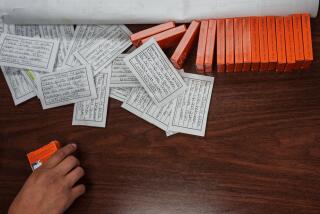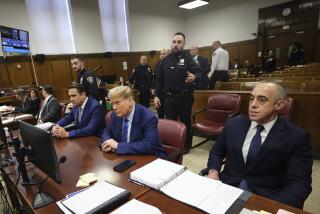Major Tobacco Trial Opening in Minnesota
- Share via
After a 3 1/2-year buildup, the most important trial in the history of the tobacco industry is set to begin today in a courtroom in St. Paul, Minn.
Attorneys for Minnesota will finally put before a jury the potentially powerful, but still untested, legal theory that the nation’s cigarette makers owe the state at least $1.7 billion for costs incurred by treating sick smokers. With the possibility of punitive damages and special antitrust damages, the industry’s exposure may be much larger.
But far more than money is at stake. If further damaging revelations about the cigarette companies emerge from the trial, it could result in Congress imposing more draconian terms on the industry than are contained in the $368.5-billion proposed national tobacco settlement, according to legal and political observers.
“This is the trial that is likely to influence public and regulatory attitudes,” said Calvert D. Crary, litigation analyst at Auerbach, Pollak & Richardson in Stamford, Conn. Referring to the 33 million pages of industry documents Minnesota’s lawyers have gotten in pretrial discovery, he added: “All those horrifying documents that are certain to come out will alter the context of the congressional debate and change that debate.”
The case also puts Minnesota Atty. Gen. Hubert H. Humphrey III, heir to one of the most famous names in modern American politics, squarely in the national spotlight.
Humphrey, who has emerged as one of the industry’s staunchest foes, is running for governor, and the outcome of the trial very likely will have a major effect on the race. Humphrey has promised that Minnesota’s trial team, led by private attorneys Michael Ciresi and Roberta Walburn, will unveil “smoking howitzer” documents during the case.
Humphrey was the second attorney general to sue the tobacco industry, filing his suit in August 1994, three months after Mississippi Atty. Gen. Mike Moore. For many months, the two worked in tandem, but they eventually reached a sharp divide.
Moore took the lead role in negotiating the June settlement, while Humphrey strongly opposed the pact. He branded it a “Trojan Camel” that would pave the way for cigarette makers to remain highly profitable while gaining significant legal protections.
Since June, the industry, hoping to avoid negative publicity from court cases while Congress considers the proposed national deal, reached separate eve-of-the-trial settlements totaling $30 billion with three states: Mississippi, Florida and Texas.
The industry also wants a peace pact with Humphrey to prevent negative publicity, according to tobacco analysts. Several analysts predict that Minnesota will settle once the trial is underway for about $4.5 billion--the amount of money the state would get as its portion of the national settlement.
State Is Hardly Friendly Venue
Another reason for the cigarette companies to settle is that Minnesota, with some of the nation’s toughest tobacco-control laws as well as strong antitrust and consumer protection statutes, is hardly a friendly forum for them.
Moreover, as the case has progressed toward trial, Ramsey County District Judge Kenneth J. Fitzpatrick has become increasingly critical of the industry’s tactics and has issued several stinging rulings, all of which have been upheld by appellate courts.
In one decision ordering the cigarette companies to turn over a mass of internal documents, Fitzpatrick said that the “court’s own review of the documents reveals a conspiracy of silence and suppression of scientific research.”
Gary Black of Sanford Bernstein & Co., one of the leading tobacco analysts on Wall Street, thinks that Humphrey will eventually settle, noting it simply makes sense.
“In the end,” Black said in a phone interview, “I can’t believe that Humphrey will take a chance that a jury may not give him money, because he would look like a goat if he turns down $4.5 billion to get potentially $1.7 billion.”
For his part, Humphrey said late last week that he is willing to settle--but not compromise. He warned the industry that “in Minnesota, the ground rules are different” from those in the states that have settled.
“The line in the snow has been drawn,” he said.
Minnesota would settle under three conditions, he said: that the industry disgorge all of its internal documents, provide ironclad assurances that it will stop marketing its products to kids and “pay in full for the damage it has caused.” Humphrey did not say how much money would be required to meet the third condition.
However, in a pointed reference to the $4.5-billion figure, Humphrey’s chief aide, Eric Johnson, said: “We’re not a party to that settlement, and we’re not constrained by that settlement.”
Both pro- and anti-tobacco observers said they think the industry is unlikely to meet Humphrey’s demand for immediate public disclosure of the documents, thereby complicating settlement prospects.
So far, most of the 33 million documents Minnesota has obtained remain under seal, pending trial. In addition, the industry is still fighting to keep secret an additional 250,000 pages of material Minnesota’s lawyers have been trying to obtain for more than a year.
“If the industry disgorges the documents before there is a national settlement, they would be waiving their claims of privilege” to the documents in other cases, said tobacco analyst Martin Feldman of Smith Barney.
And as soon as another huge cache of documents becomes available, industry foes in Congress, such as Rep. Henry A. Waxman (D-Los Angeles), are likely to call for further hearings about the disclosures in those papers, noted Richard Daynard, founder of the Tobacco Products Liability Project at Boston’s Northeastern University Law School.
For now, the only thing that seems certain is that lawyers will start questioning prospective jurors under the supervision of Judge Fitzpatrick this morning in the federal courthouse in St. Paul.
Fitzpatrick moved the case from his state courtroom to get larger accommodations because of the huge numbers of lawyers involved and the demand for seats by journalists from around the country.
The industry has had more than 100 attorneys working on the case at one time or another--60 of whom are from out of state and have been specially admitted to practice in Minnesota for this case. Nearly a year ago, an industry lawyer said in a brief that the cigarette companies already had spent $100 million simply producing documents in the case.
The plaintiffs have submitted a list of 21,000 possible exhibits during the trial, and the defense has given the judge a list of 27,000 possible exhibits. It is unlikely that they all will be used, and one of the most difficult tasks for an attorney in a case of this size is figuring out how to prune the case to a manageable scope for a jury.
Although there have been about 2,000 briefs and thousands more exhibits publicly filed in the case, many briefs, expert witness reports and scores of depositions remain under seal. Moreover, the industry has filed papers asking that some of its documents not be publicly aired during the trial, a move the plaintiffs are fighting.
Case Is Compared to Oil Spill Damages
Once testimony begins, the state--and its co-plaintiff, Blue Cross and Blue Shield of Minnesota--will start unveiling documents and presenting witnesses in an attempt to establish that the tobacco companies have as much obligation to compensate Minnesota for damages caused by their product as an oil company has for the cost of cleaning up a spill.
Minnesota, represented by the Minneapolis law firm of Robins, Kaplan, Miller & Ciresi, contends that the industry engaged in a 40-year conspiracy to suppress the health hazards of smoking; broke its promise to the public to conduct independent scientific research on the health effects of smoking; acted in collusion to prevent development of a safer cigarette; and lured kids into smoking and hooked them by manipulating the level of nicotine, the addictive component of cigarettes.
For their part, industry lawyers say they are confident they can prevail in front of a jury.
More to Read
Sign up for Essential California
The most important California stories and recommendations in your inbox every morning.
You may occasionally receive promotional content from the Los Angeles Times.













